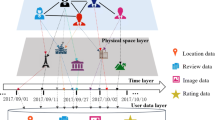Abstract
Value added services are based on user context awareness. Important context aspect is location, which could be extended to future locations if services had the ability to predict movement. We propose a model for user movement prediction based on traffic topology. Benefits of the model are presented on example service, while the performance is evaluated on real user movement data.
This work was carried out within the research projects “Content Delivery and Mobility of Users and Services in New Generation Networks” and “Knowledge-based network and service management”, supported by the Ministry of Science, Education and Sports of the Republic of Croatia.
Access this chapter
Tax calculation will be finalised at checkout
Purchases are for personal use only
Preview
Unable to display preview. Download preview PDF.
Similar content being viewed by others
References
Quintero, A.: A user pattern learning strategy for managing users’ mobility in umts networks. IEEE Transactions on Mobile Computing 4(6), 552–566 (2005)
Majumdar, K., Das, N.: Mobile user tracking using a hybrid neural network. Wirel. Netw. 11(3), 275–284 (2005)
Krumm, J., Horvitz, E.: Predestination: Inferring Destinations from Partial Trajectories. In: Dourish, P., Friday, A. (eds.) UbiComp 2006. LNCS, vol. 4206, pp. 243–260. Springer, Heidelberg (2006)
Karimi, H.A., Liu, X.: A predictive location model for location-based services. In: GIS 2003: Proceedings of the 11th ACM International Symposium on Advances in Geographic Information Systems, pp. 126–133. ACM, New York (2003)
Ashbrook, D., Starner, T.: Learning significant locations and predicting user movement with gps. In: Proceedings of the 6th International Symposium on Wearable Computers, ISWCí 2002 (2002) 0-7695-1816-8/02
González, M.C., Hidalgo, C.A., Barabási, A.-L.: Understanding individual human mobility patterns. Nature 453, 779–782 (2008)
Islam, M.M., Murshed, M., Dooley, L.S.: New mobility based call admission control with on-demand borrowing scheme for qos provisioning. In: ITCC 2003: Proceedings of the International Conference on Information Technology: Computers and Communications, p. 263 (2003)
Hou, J., Fang, Y.: Mobility-based call admission control schemes for wireless mobile networks. Wireless Communications and Mobile Computing 1(3), 269–282 (2001)
Hsueh, Y., Lee, D.: A bandwidth reservation scheme based on road information for the next generation cellular networks. IEEE Trans. Veh. Technol. 53(1), 243–252 (2004)
Kim, H., Soh, W.: Dynamic bandwidth reservation in cellular networks using road topology based mobility predictions. In: Proceedings of the IEEE INFOCOM 2004, vol. 4, pp. 2766–2777 (2004)
Yavas, G., Katsaros, D., Ulusoy, O., Manolopoulos, Y.: A data mining approach for location prediction in mobile environments. Data Knowl. Eng. 54(2), 121–146 (2005)
Liu, X., Karimi, H.A.: Location awareness through trajectory prediction. Computers, Environment and Urban Systems 30(6), 741–756 (2006)
Vukovic, M., Lovrek, I., Jevtic, D.: Predicting User Movement for Advanced Locationaware Services. In: Proceedings of the 15th International Conference on Software, Telecommunications and Computer Networks, FESB, University of Split. (2007)
Jevtic, D., Car, Z., Vukovic, M.: Location name extraction for user created digital content services. In: Apolloni, B., Howlett, R.J., Jain, L. (eds.) KES 2007, Part I. LNCS (LNAI), vol. 4692, pp. 623–630. Springer, Heidelberg (2007)
Eagle, N., Pentland, A., Lazer, D.: Inferring Social Network Structure using Mobile Phone Data. Proceedings of the National Academy of Sciences 106(36), 15274–15278 (2009)
Author information
Authors and Affiliations
Editor information
Editors and Affiliations
Rights and permissions
Copyright information
© 2011 Springer-Verlag Berlin Heidelberg
About this paper
Cite this paper
Vukovic, M., Jevtic, D., Lovrek, I. (2011). User Movement Prediction Based on Traffic Topology for Value Added Services. In: König, A., Dengel, A., Hinkelmann, K., Kise, K., Howlett, R.J., Jain, L.C. (eds) Knowledge-Based and Intelligent Information and Engineering Systems. KES 2011. Lecture Notes in Computer Science(), vol 6881. Springer, Berlin, Heidelberg. https://doi.org/10.1007/978-3-642-23851-2_37
Download citation
DOI: https://doi.org/10.1007/978-3-642-23851-2_37
Publisher Name: Springer, Berlin, Heidelberg
Print ISBN: 978-3-642-23850-5
Online ISBN: 978-3-642-23851-2
eBook Packages: Computer ScienceComputer Science (R0)




